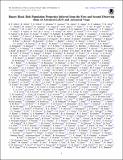Binary Black Hole Population Properties Inferred from the First and Second Observing Runs of Advanced LIGO and Advanced Virgo
Author(s)
LIGO Scientific Collaboration; Virgo Collaboration
DownloadPublished version (4.770Mb)
Publisher Policy
Publisher Policy
Article is made available in accordance with the publisher's policy and may be subject to US copyright law. Please refer to the publisher's site for terms of use.
Terms of use
Metadata
Show full item recordAbstract
© 2019. The American Astronomical Society. All rights reserved. We present results on the mass, spin, and redshift distributions with phenomenological population models using the 10 binary black hole (BBH) mergers detected in the first and second observing runs completed by Advanced LIGO and Advanced Virgo. We constrain properties of the BBH mass spectrum using models with a range of parameterizations of the BBH mass and spin distributions. We find that the mass distribution of the more massive BH in such binaries is well approximated by models with no more than 1% of BHs more massive than 45 M and a power-law index of (90% credibility). We also show that BBHs are unlikely to be composed of BHs with large spins aligned to the orbital angular momentum. Modeling the evolution of the BBH merger rate with redshift, we show that it is flat or increasing with redshift with 93% probability. Marginalizing over uncertainties in the BBH population, we find robust estimates of the BBH merger rate density of R= (90% credibility). As the BBH catalog grows in future observing runs, we expect that uncertainties in the population model parameters will shrink, potentially providing insights into the formation of BHs via supernovae, binary interactions of massive stars, stellar cluster dynamics, and the formation history of BHs across cosmic time.
Date issued
2019Department
LIGO (Observatory : Massachusetts Institute of Technology); Massachusetts Institute of Technology. Department of Physics; MIT Kavli Institute for Astrophysics and Space ResearchJournal
Astrophysical Journal Letters
Publisher
American Astronomical Society